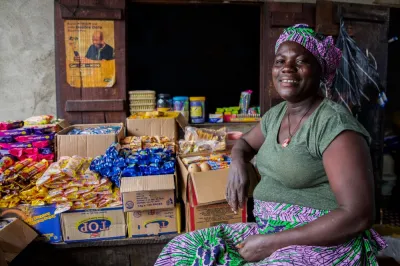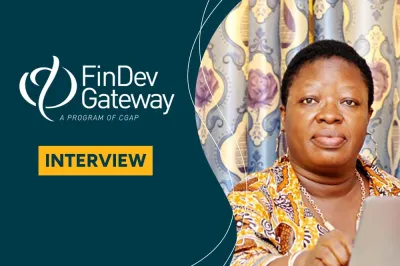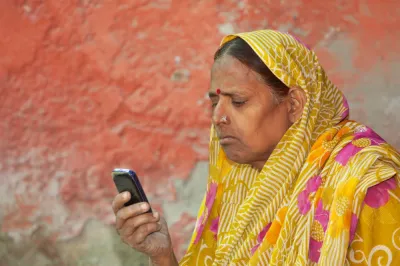Should We Be Talking About Financial Health Instead of Inclusion?

Carrie Creasey is a Program Specialist for MetLife Foundation, where she manages global grant-making, impact evaluation, and strategic storytelling to support the Foundation’s mission to accelerate the financial well-being of low-income people globally. Through partnerships with over 170 financial inclusion organizations across 40 countries, the Foundation has committed more than USD 170 million to-date and is on track to support more than 20 million people on their journey towards financial health.
Gateway: You recently spoke at the SEEP Conference in a session entitled "Reframing the Conversation from Financial Inclusion to Financial Health." Can you tell us a little bit about the concept of "financial health," what it involves, and why it matters?
Carrie: Financial health means that people are able to effectively manage their day-to-day cash flow needs, have resilience in the face of life’s inevitable challenges, and take advantage of opportunities. In other words, they can achieve their short and long-term financial goals.
Broadly speaking, I think that these are outcomes most practitioners in the financial inclusion space have wanted to support all along; however, the terminology we’ve been using doesn’t fully convey this. The term financial inclusion is binary, leaving us with just two options: you’re either “included” in the formal financial ecosystem or you’re “excluded.” Yet we know that the issue is not this simple. It’s not enough for low-income and marginalized populations to have access to financial products and services; what matters is if and how they are able to use these tools to positively impact their lives.
Gateway: As the panel noted, we are becoming "increasingly aware that traditional measures of financial inclusion often reveal little about the financial health of a society." What does the concept of financial health tell us about that financial inclusion doesn't?
Carrie: I like to use my home country, the United States, as an example because I often find that people are shocked by how stark the contrast between financial inclusion and financial health can be even in a country we think of as very developed.
In 2015, the U.S. Census Bureau and the FDIC (Federal Deposit Insurance Corporation) co-released a report stating that 93% of American households were “banked” – meaning they held an account with a formal financial institution. From a financial inclusion standpoint, that sounds like a real success.
The term financial inclusion is binary, leaving us with just two options: you’re either “included” in the formal financial ecosystem or you’re “excluded.” Yet we know that the issue is not this simple.
However, that very same year CFSI (Center for Financial Services Innovation), one of MetLife Foundation’s key U.S. partners, released its own findings that revealed that 57% of Americans were still struggling with their financial health. In addition, the Federal Reserve reported that almost half of U.S. families (46%) did not have just $400 to cover an unexpected cost in the case of an emergency.
What seems like “success” if we only evaluate how many Americans are banked, actually becomes a serious financial health crisis when we look more closely at their everyday financial lives.
Gateway: How do you measure financial health? What kind of data is available on this concept?
Carrie: A lot of insights and data around financial health are still emerging, and there’s certainly no universally agreed upon language or set of metrics available yet. Nonetheless, there are organizations working to change this.
CFSI, a group I mentioned before, has developed a framework based on its research in the U.S., which evaluates indicators of financial health centered on four major components – how you spend, save, plan, and borrow. Additionally, MetLife Foundation is partnering with Gallup to conduct a global pilot study to assess the financial well-being of individuals across 10 diverse countries, which will survey 15,000 individuals. That study is still in the early stages, but the goal is to accumulate robust data that can be used to develop a reliable metric for overall financial health on an international scale.
No matter what data organizations collect, it will be crucial to track outcomes – for both clients and institutions – over more extended periods of time. Indicators of financial health need to be focused on the long-term impact for low-income populations.
Gateway: Work on financial health began with a focus on consumers in the developed country of the United States, but it is also gaining momentum globally. Does the concept or framework vary between countries, or depending on level of economic development?
Carrie: Any time you try to measure impact on a global scale things become tricky. I do believe that the core concepts of being able to manage day-to-day needs, securely face financial challenges, and take advantage of opportunities are universally acceptable indicators of financial health, and that having some type of global metric is always helpful for assessing issues at scale. That being said, as organizations dive deeper into evaluating different countries and communities, I recognize the importance of leveraging culturally-appropriate data. It doesn’t necessarily make sense to focus on how much money people are saving each month in a country like Argentina – where inflation rates are high – or South Sudan – where the number of cows you own may matter a lot more than money in the bank.
I don’t think we need to ditch financial inclusion, but perhaps it’s time to challenge our thinking on the concept.
Gateway: So, are we done now with the term "financial inclusion?" Do you think it's time to ditch that concept and focus on financial health?
Carrie: I don’t think we are done with financial inclusion. As a term, it has been very useful in bringing together policymakers, donors, practitioners, academics and customers. To date, there are fifty-plus countries with financial inclusion strategies – and that’s no small feat. I don’t think we need to ditch financial inclusion, but perhaps it’s time to challenge our thinking on the concept. I know that many of the Gateway’s readers started out in this field during the days of “microenterprise credit,” and eventually dropped the “enterprise” in favor of “micro-credit” before moving on to “microfinance,” and eventually expanding to financial inclusion. This is an industry that has proven itself adept at evolving to address the needs of low-income and financially vulnerable people. I am confident it will continue to do so, regardless of the title.
Related Reading:
- Eight Ways to Measure Financial Health (CFSI, May 2016)
- Consumer Financial Health Study (CFSI, Mar 2015)


